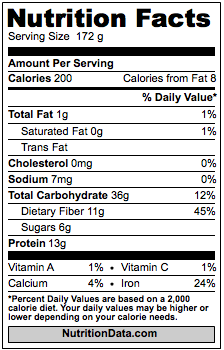If you're just joining in, check out part 1 and part 2 of this series. It is also important for you to know that all of the information I am sharing here came from a presentation by Dana Mcgehee, a local mom who is passionate about healthy eating. I know what I have been sharing is barely scraping the top of the massive amounts of information out there about eating healthy. I think Dana's goal was to share the starter tools to help us make better choices in the grocery store. In my opinion, the most valuable thing she shared is her method of reading nutrion labels and deciding if food items have enough nutritional value to consume.
Below is her tutorial:
 Step 1: Go get a product from your pantry or fridge and flip to the nutrition facts label. Seriously, go get one. It will help you learn and remember this process so you can use it when you are away from the computer. :)
Step 1: Go get a product from your pantry or fridge and flip to the nutrition facts label. Seriously, go get one. It will help you learn and remember this process so you can use it when you are away from the computer. :)
Step 2: Look at the list of ingredients. Ingredients are ordered from the most-used to the least-used ingredient. If the first ingredient is sugar that means it has more sugar in it than any other ingredient used - put the product back on the shelf.
Step 3: Look at the sugar content (under carbohydrate information). 9 grams is good, 6 is better, 4 is BEST. If there are more than 9g of sugar in one serving - put the product back on the shelf.
Step 4: Look at the calorie count. Then look to the right and observe how many calories from fat are listed. Multiply the calories from fat by 3. If the answer is greater than the number of calories in the product, it is very high in fat content. Put it back.
Step 5: If your food still qualifies to be added to your cart, glance at the fiber and protein counts. This is where you find the nutritional value. Obviously, if they are 0, there isn't much nutritional value. Use your own judgement when deciding if the food has enough nutritional value for you at this point.
With that information, I feel confident walking through the grocery store and choosing items based on their nutritional value. As I said earlier, all of this information is just the beginning of educating ourselves about living a healthier lifestyle. Below are some resources I plan on using to further educate myself and help inspire me to keep stepping forward in this journey. I hope you will find some of them helpful as well!
Resources for your journey (* denotes a recommendation by Dana)
Books:
- The Eat-Clean Diet by Tosca Reno*
- Ellie Krieger's books and website
- Healthy Choices for Women (a devotional)*
- Food, Fitness & Faith (for women)*
- Made to Crave
- Deceptively Delicious (cookbook)*
- The Sneaky Chef (cookbook)
Websites / blogs:
And lastly, I want to wrap up the series with a few other random pieces of info that Dana shared:
- Children should consume between 20 and 40 grams of fiber DAILY
- Thursday are grocery clearance/sale days locally.
- Hummus is an awesome power-food and easy to make at home.
- Too much sugar is hard on the liver.
- Consider this a JOURNEY, as it has no end.
"If we neglect the Bible, we cannot benefit from God's wisdom. If we neglect to have faith we cannot benefit from God's love. And if we neglect our physical health we cannot benefit from a long, healthy life."
I hope all of this information has helped encourage you to make small changes that can make a big difference in your life. I will try to continue to share bits of our journey, including recipes and new information I learn along the way. Good luck!!

